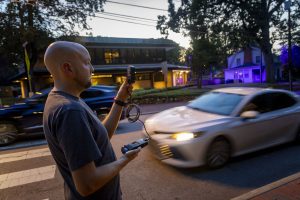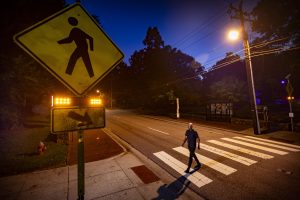Illuminating yielding behavior: How time and light affect driver responses to pedestrians
HSRC researchers are currently testing the rate at which drivers yield to pedestrians at crossings with rectangular rapid flashing beacons (RRFBs). An RRFB is a special type of flashing light used in combination with signs at crosswalks to alert drivers that pedestrians are attempting to cross the street so that they can stop for them. You might see them near schools, parks, or busy roads where people often cross.

The purpose of the project, which is supported by the Insurance Institute for Highway Safety (IIHS), is to understand the effectiveness of RRFBs at night and in different lighting conditions in various testing locations in HSRC’s hometown of Chapel Hill, NC, including one on the Carolina campus. During each observational field study session, how drivers respond both when the flashers are activated and when they are not activated is recorded.
“This project will help us better understand the relationship between ambient lighting and the efficacy of RRFBs at night,” said Wes Kumfer, HSRC Senior Engineering Research Associate and Principal Investigator on the project.
“We are still collecting data, but one thing that stands out is that drivers seem far more likely to yield when the RRFB is activated,” said Kumfer. “It’s very obvious to members of the community who are walking by as we’re conducting our research too, which has lead to a few requests to have RRFBs installed at every pedestrian crossing in Chapel Hill already. We’re hoping the final results of this project will reveal the lighting conditions in which this technology is the most effective for anyone planning and managing roadway lighting and infrastructure in their communities. Improving pedestrian safety here and everywhere is the ultimate goal.”

This project is a follow up to a previous IIHS project that also aimed to help local transportation agencies decide on the most appropriate nighttime safety features to promote pedestrian safety. This phase two project involves the project team conducting data collection at crossings after dark at sites throughout Chapel Hill that have different levels of illumination. In addition to measuring yielding rates, the team is collecting data on the speeds of vehicles approaching a crossing and going through the crossing in cases where the driver does not yield. Half of the crossings are made when the RRFB is not activated in order to allow for comparisons in yielding rates.